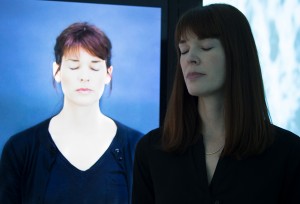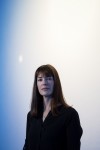Erin Cooney recorded herself grieving over climate change.
The video is paired with sounds of insects and other animal life in a Puerto Rican rainforest, which fade out over time to represent the fauna diminishing since the 1970s.
The graduate student’s installation is part of UCLA’s department of design media arts exhibition, “I Need the Sea Because It Teaches Me.” The solo show will take place Tuesday after a panel discussion on the discourse art provides on climate change. Cooney said her exhibition, titled after a line in poet Pablo Neruda’s “The Sea,” intends to help viewers reflect on the natural world through her personal reactions to the changes occurring.
“I think it’s important to have an emotional response to the truth of climate change,” she said. “It’s an attempt to make emotional space for feeling the catastrophe.”
One of the pieces in Cooney’s exhibition is a close-up video of her own face called “Grieve With Me.” She said the shot captures her tearful response to an article she read about the dwindling insect and animal populations in El Yunque, a Puerto Rican national forest. The study suggested that the forest’s invertebrate biomass has decreased to about a fourth or less of figures recorded in 1976.

[RELATED: Interdisciplinary art installation displays symbiosis of people, nature]
Marc Mannheimer, an artist and professor at Northern Essex Community College, gave Cooney a solo show in 2016 and said her choice to include footage of herself is part of an ongoing trend in her work that deals with capturing the individual’s response to their environment. Reacting to the topic of climate change through grieving helps make the topic personal rather than political, he said.
“(Cooney’s) work has always been intellectual and this is very intellectual, but also I think it’s more guttural. She’s not doing this as an editorializing of the concept,” he said. “She’s showing herself being emotionally affected by it.”
Another installation called “The Waves” incorporates projections of waves on two walls and four LCD monitors arranged in a square with the screens facing outward. As viewers walk around the monitors, Cooney said they will hear four separate narrations, each corresponding to one screen.
Cooney said each of the self-narrated tracks captures a different emotional tonality in response to the idea of the oceans’ independence from people; it continues on regardless of human interference. She said the narrations represent her own four conflicting feelings after coming to such a realization – awe-inspired, sad, scared and angry. Though each narration uses the same words, she said her vocal intonation and facial expressions change across audio tracks.
“(The waves are) going on whether you’re there or not to see them,” she said. “All four of these people – this fractured person – are speaking their story together at once.”
[RELATED: Art show seeks to highlight diverse roles in the environmental justice movement]
Another piece on display, “Clair de Lune,” involves a view of the moon from under the ocean waves. Translating to “moonlight” in English, the piece also incorporates audio from French composer Claude Debussy’s “Claire de Lune,” to which the piece owes its name. Cooney said she worked with graduate student Daniel Bayot to run the song through software, applying a wave filter to it. The sounds are distorted and the tempo rises and falls in an emulation of currents, she said.
“Clair de Lune” is a conceptual take on the ocean without any human presence involved, Cooney said. The camera angle captures the ocean’s viewpoint. She said the shots work in conjunction with the music’s wavering tempo to speculate about the ocean’s calm nature when humans are not around to witness it.
The piece is part of an overall exhibition that Victoria Vesna, a member of the panel and a design media arts professor at UCLA, said deals with the topic of climate change through a gut response rather than solely through statistics or information. It is part of an artistic trend she said involves engaging viewers through emotional appeals, but also giving them avenues to study the topic in-depth in other ways – through a panel, for instance.
“It’s a nice, poetic space but you engage the discussion on a deeper level from different points of view,” Vesna said.
Vesna, the director of the UCLA Art|Sci Center, said more artists are beginning to create emotional pieces in response to scientific data. She said she even created a virtual reality piece about plankton, scaling them to the size of whales, in response to the effects microplastics have on the creatures. The size helps viewers realize the intricacies of plankton and encourage an emotional response, she said, while further information about the organisms can be found on the project’s website.
Climate change and other topics of public discourse are important to address through art, Cooney said. Art can directly discuss topics like climate change, such as in “Grieve With Me,” or it can put people into different perspectives to view topics through different eyes, like in “Clair de Lune,” she said.
“We have to change our relationship to the natural world. We can’t keep going seeing it as purely an extractive resource for our personal use,” Cooney said. “It’s important to create work that urges viewers to reframe that relationship (between themselves and the environment).”
